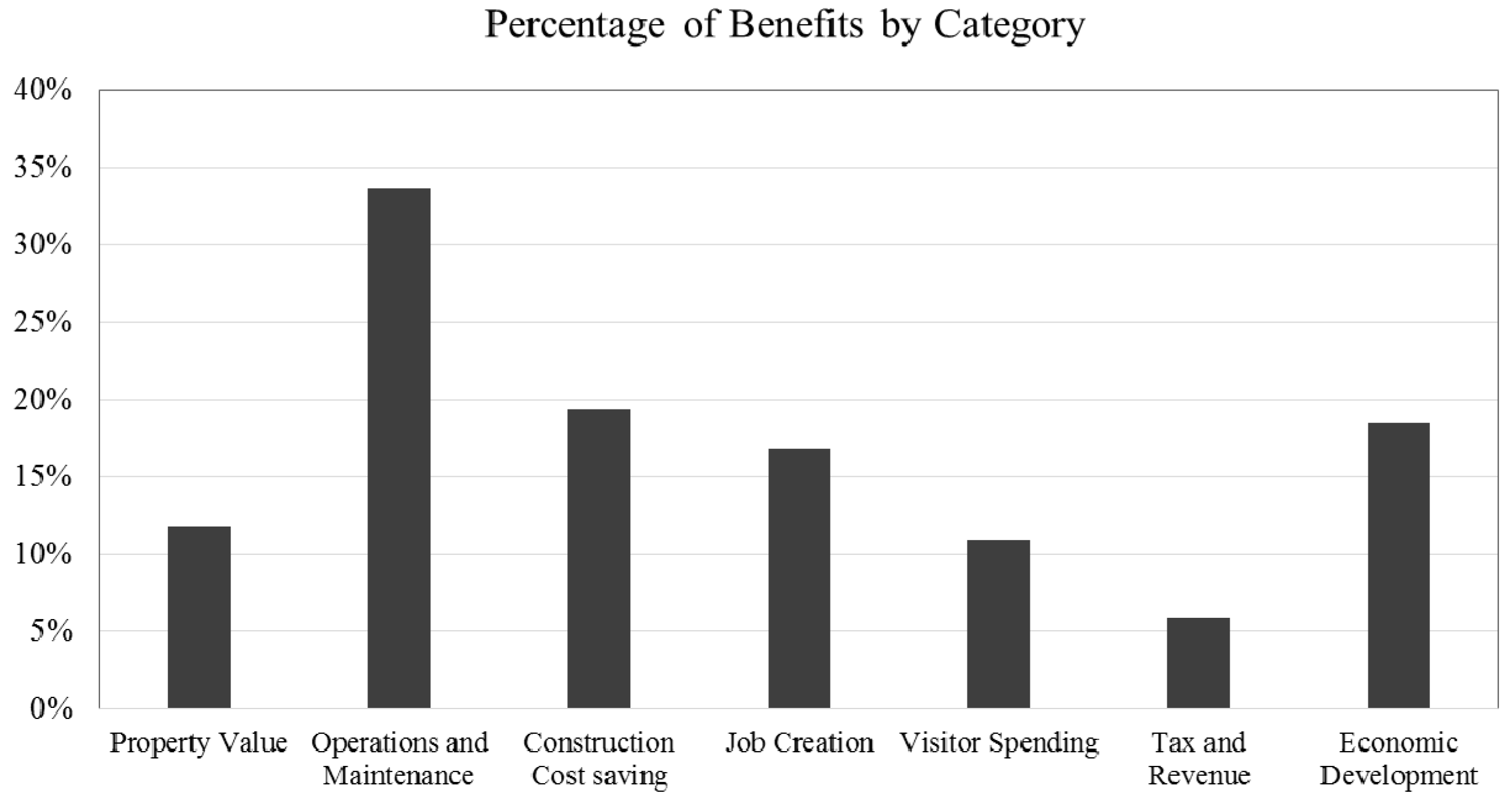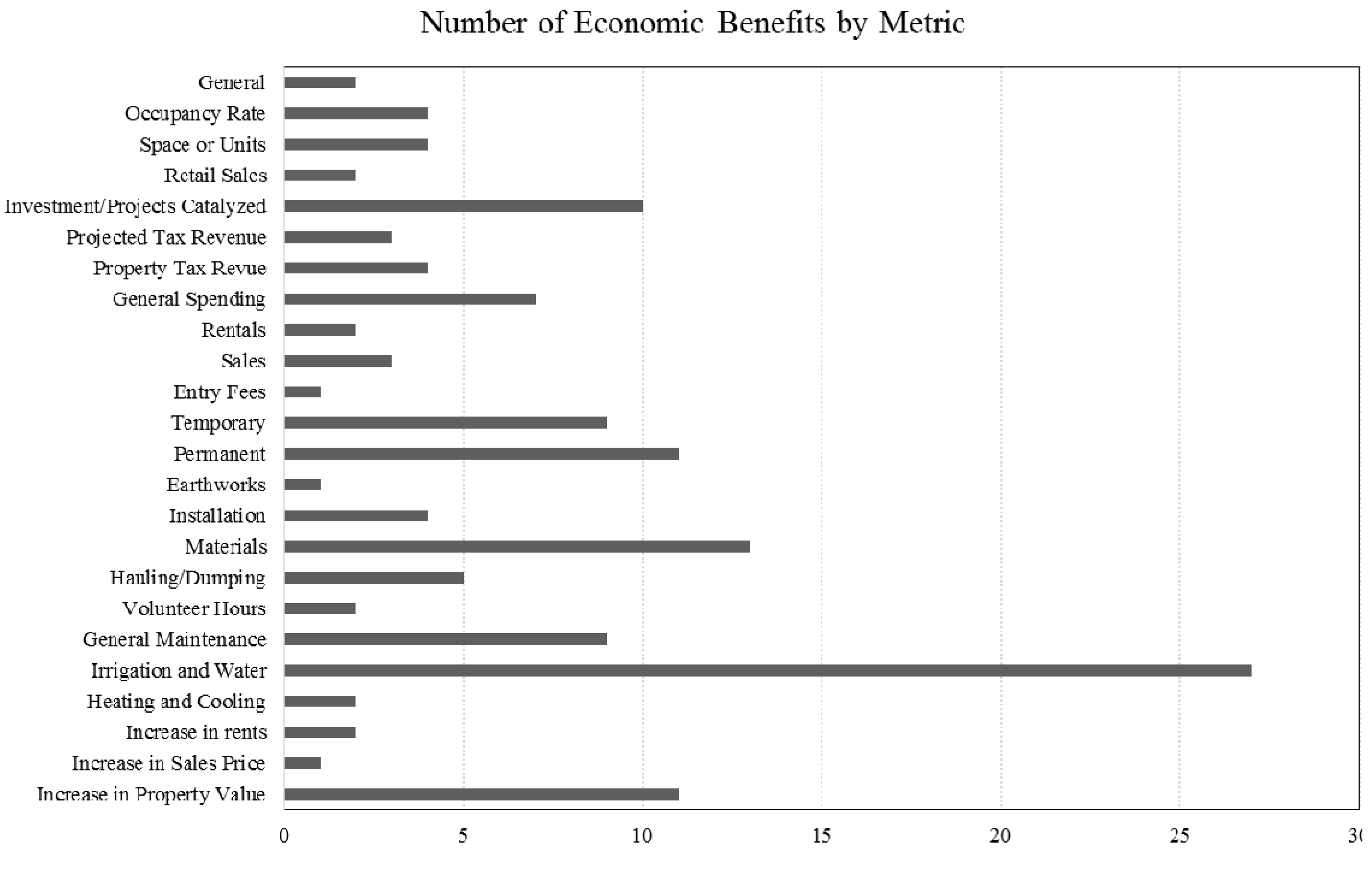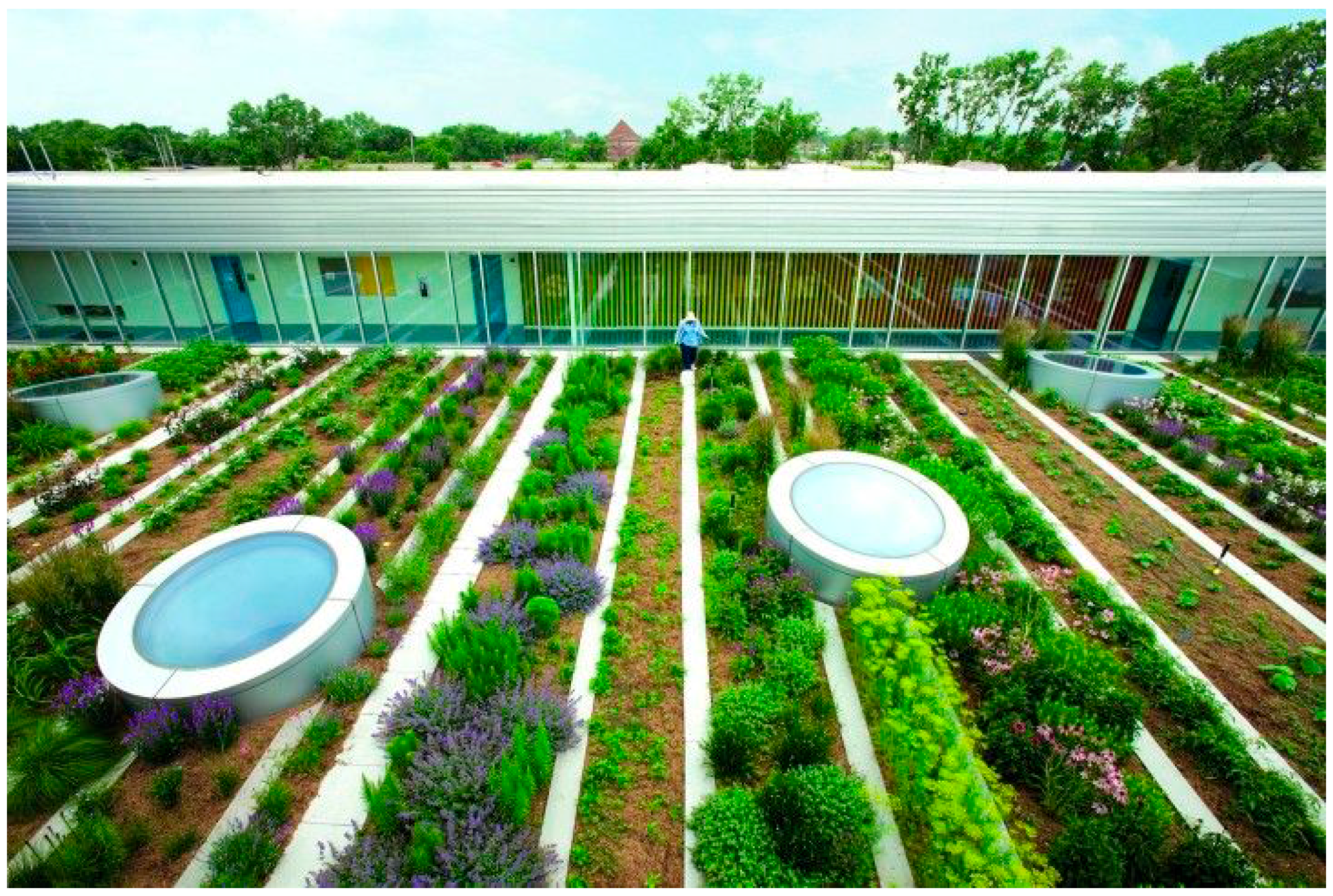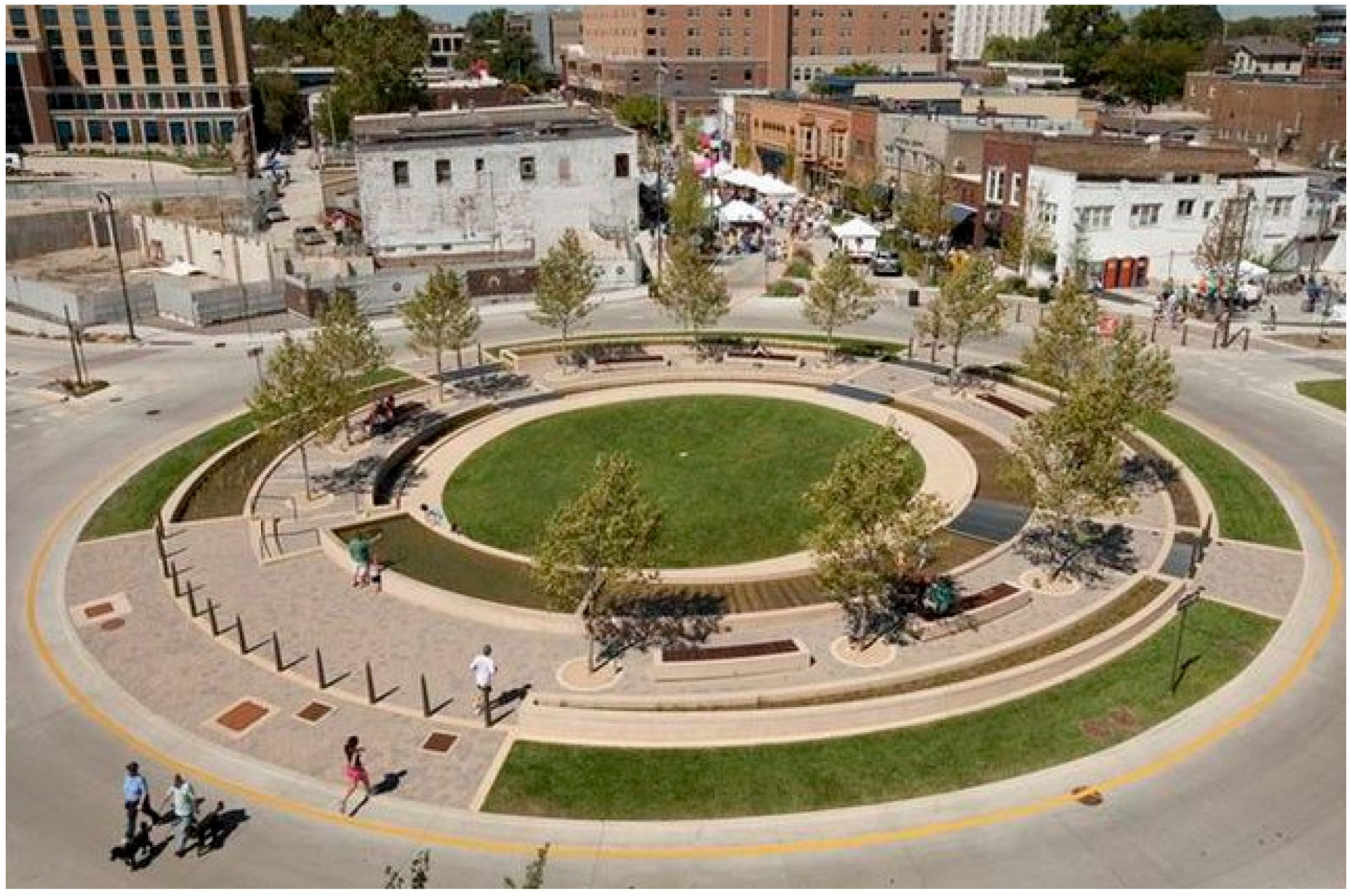Economic Benefits: Metrics and Methods for Landscape Performance Assessment
Abstract
:1. Introduction
2. Economic Benefits Categories and LPS Assessment Status
3. Existing Metrics and Methods in LPS
3.1. Property Values
3.2. Operations and Maintenance Savings
3.3. Construction Cost Savings
3.4. Job Creation
3.5. Visitor Spending
3.6. Increased Tax Base/Revenue
3.7. Economic Development
4. Case Studies
4.1. Gary Comer Youth Center—An Example of Operations-and-Maintenance Savings
4.2. Blue Hole Regional Park—an Example of Construction-Cost Savings
4.3. Uptown Normal Circle and Streetscape—an Example of Economic Development
5. Discussion
5.1. Considerations for Improvement
5.2. Implications to Landscape Architecture Education and Design Process
6. Conclusions
Acknowledgments
Author Contributions
Conflicts of Interest
Abbreviations
| LPS | the Landscape Performance Series |
| LAF | the Landscape Architecture Foundation |
| GCYC | The Gary Comer Youth Center |
References and Notes
- Faber, M. How to be an ecological economist. Special section: Integrated hydro-economic modelling for effective and sustainable water management. Ecol. Econ. 2008, 66, 1–7. [Google Scholar] [CrossRef]
- Luo, Y.; Li, M.-H. A study of landscape performance: Do social, economic and environmental benefits always complement each other? Landsc. Resear. Rec. 2013, 1, 566–577. [Google Scholar]
- Yang, B.; Zhang, Y.; Blackmore, P.; Zhang, Y.; Blackmore, P. Performance and economic benefits of four streetscape renovations: A comparative case study investigation. Landsc. Resear. Rec. 2014, 2, 300–309. [Google Scholar]
- Ozdil, T.R.; Stemart, D.M.; Feng, Y.-J.; Ren, W. Assessing economic performance of landscape architecture projects: Lessons learned from texas case studies. Landsc. Archit. 2015, 1, 70–86. (In Chinese) [Google Scholar]
- Ioppolo, G.; Cucurachi, S.; Salomone, R.; Saija, G.; Shi, L. Sustainable Local Development and Environmental Governance: A Strategic Planning Experience. Sustainability 2016, 8, 180. [Google Scholar] [CrossRef]
- Wang, Z.; Tan, P.Y.; Zhang, T.; Nassauer, J.I. Perspectives on narrowing the action gap between landscape science and metropolitan governance: Practice in the us and china. Landsc. Urban Plann. 2014, 125, 329–334. [Google Scholar] [CrossRef]
- Canfield, J.; Yang, B. Reflections on developing landscape performance case studies. Landsc. Resear. Rec. 2014, 2, 310–317. [Google Scholar]
- Canfield, J.; Yang, B.; Whitlow, H.; Burgess, K.; Koudounas, A. Landscape Performance: A Guidebook for Metric Selection; Landscape Architecture Foundation: Washington, DC, USA, 2015. [Google Scholar]
- Ndubisi, F.; Whitlow, H.; Deutsch, B.; Duan, S.-L.; Zhang, X.-W. Landscape performance: Past, present, and future. Landsc. Archit. 2015, 1, 40–51. (In Chinese) [Google Scholar]
- Preiser, W.F.E.; Rabinowitz, H.Z.; White, E.T. Post-Occupancy Evaluation; Van Nostrand Reinhold company: New York, NY, USA, 1988. [Google Scholar]
- Brown, R.D.; Corry, R.C. Evidence-based landscape architecture: The maturing of a profession. Landsc. Urban Plann. 2011, 100, 327–329. [Google Scholar] [CrossRef]
- Brink, A.V.D.; Bruns, D. Strategies for enhancing landscape architecture research. Landsc. Resear. 2014, 39, 1–14. [Google Scholar]
- Ervin, J.; Mulongoy, K.J.; Lawrence, K.; Game, E.; Sheppard, D.; Bridgewater, P.; Bennett, G.; Gidda, S.B.; Bos, P. Making protected areas relevant: A guide to integrating protected areas into wider landscapes, seascapes and sectoral plans and strategies. In CBD Technical Series No. 44; Convention on Biological Diversity: Montreal, Canada, 2010; p. 94. [Google Scholar]
- Felson, A.J.; Pickett, S.T. Designed experiments: New approaches to studying urban ecosystems. Front. Ecol. Environ. 2008, 3, 549–556. [Google Scholar] [CrossRef]
- Mission of the Landscape Architecture Foundation (LAF). Available online: http://landscapeperformance.org/about-landscape-performance (accessed on 10 August 2014).
- Yang, B.; Li, S.; Binder, C. A research frontier in landscape architecture: Landscape performance and assessment of social benefits. Landsc. Resear. 2016, 41, 314–329. [Google Scholar] [CrossRef]
- Francis, M. A case study method for landscape architecture. Landsc. J. 2001, 20, 15–29. [Google Scholar]
- Green Roof Energy Calculator. Available online: http://greenbuilding.pdx.edu/GR_CALC_v2/grcalc_v2.php#retain (accessed on 5 December 2014).
- Tyrväinen, L.; Miettinen, A. Property prices and urban forest amenities. J. Environ. Econ. Manag. 2000, 39, 205–223. [Google Scholar] [CrossRef]
- Thompson, J.W.; Sorvig, K. Sustainable Landscape Construction: A Guide to Green Building Outdoors; Island Press: Washington, DC, USA, 2000; Volume 91, pp. 82–83. [Google Scholar]
- Calkins, M. The Sustainable Sites Handbook: A Complete Guide to the Principles, Strategies, and Best Practices for Sustainable Landscapes; John Wiley & Sons: Hoboken, NJ, USA, 2012. [Google Scholar]
- Steiner, F.; Simmons, M.; Gallagher, M.; Ranganathan, J.; Robertson, C. The ecological imperative for environmental design and planning. Front. Ecol. Environ. 2013, 11, 355–361. [Google Scholar] [CrossRef]
- Hubbard, P. Urban design and local economic development: A case study in birmingham. Cities 1995, 12, 243–251. [Google Scholar] [CrossRef]
- Shafik, N. Economic development and environmental quality: An econometric analysis. Oxford Econo. Papers 1994, 46, 757–773. [Google Scholar]
- Francis, M. Village homes: A case study in community design. Landsc. J. 2002, 21, 23–41. [Google Scholar] [CrossRef]
- Yocom, K.; Lacson, D. Gary Comer Youth Center. Available online: http://landscapeperformance.org/case-study-briefs/gary-comer-youth-center (accessed on 5 August 2015).
- Electricity rates for the state of Illinois are based on the U.S. Department of Energy’s Average Retail Price for Consumers by Sector, Census Division and State. 2009. Available online: http://www.eia.doe.gov/cneaf/electricity/esr/table4.xls (accessed on 15 January 2015).
- The Average Cost of Natural Gas. Available online: http://www.npga.org/i4a/pages/index.cfm?pageid=914 (accessed on 8 March 2014).
- Canfield, J.; Fagan, E. Blue Hole Regional Park. Available online: http://landscapeperformance.org/case-study-briefs/blue-hole-regional-park (accessed on 1 October 2013).
- Ellis, C.D.; Kweon, B.-S.; Alward, S.; Burke, R.L. Uptown Normal Circle and Streetscape. Available online: http://landscapeperformance.org/case-study-briefs/uptown-normal-circle-and-streetscape (accessed on 15 November 2011).
- Milburn, L.; Brown, R.D.; Mulley, S.J.; Hilts, S.G. Assessing academic contributions in landscape architecture. Landsc. Urban Plann. 2003, 64, 119–129. [Google Scholar] [CrossRef]
- Milburn, L.; Brown, R.D. Research productivity and utilization in landscape architecture. Landsc. Urban Plann. 2016, 147, 71–77. [Google Scholar] [CrossRef]
- Gobster, P.H.; Nassauer, J.I.; Nadenicek, D.J. Landscape journal and scholarship in landscape architecture: The next 25 years. Landsc. J. 2010, 29, 52–70. [Google Scholar] [CrossRef]
- Christensen, K.M.; Michael, S.E. Quantifying scholarship production among recently tenured landscape architecture faculty. Landsc. Resear. Rec. 2014, 2, 31–39. [Google Scholar]
- Simon, H.A. Models of Bounded Rationality: Behavioral Economics and Business Organization; MIT Press: Cambridge, MA, USA, 1982; Volume 2. [Google Scholar]
- Simon, H.A. Models of Bounded Rationality: Economic Analysis and Public Policy; MIT Press: Cambridge, MA, USA, 1982; Volume 1. [Google Scholar]
- Hack, G.; Birch, E.L.; Sedway, P.H.; Silver, M.J. Local planning: Contemporary Principles and Practice; ICMA: Washington, DC, USA, 2009. [Google Scholar]





| Metric | Economic Categories | ||||||||||||||||||||||
|---|---|---|---|---|---|---|---|---|---|---|---|---|---|---|---|---|---|---|---|---|---|---|---|
| Property Value | Operations and Maintenance | Construction | Job Creation | Visitor Spending | Tax Revenue | Economic Development | |||||||||||||||||
| Benefit Metrics | Increase in Property Value | Increase in Sales Price | Increase in rents | Heating and Cooling | Irrigation and Water | General Maintenance | Volunteer Hours | Hauling/Dumping | Materials | Installation | Earthworks | Permanent | Temporary | Entry Fees | Sales | Rentals | General Spending | Property Tax Revue | Projected Tax Revenue | Investment/Projects Catalyzed | Retail Sales | Space or Units | Occupancy Rate |
| Total by Category | 14 (12%) | 40 (34%) | 23 (19%) | 20 (17%) | 13 (11%) | 7 (6%) | 22 (18%) | ||||||||||||||||
| Category | Metric | Method |
|---|---|---|
| (1) Property Value | Increase in property value for adjacent or nearby properties |
|
| ||
| ||
| Increases in sales price for adjacent or nearby properties |
| |
| Increases in rents for adjacent residential or commercial properties |
| |
| (2) Operations and Maintenance Savings | Reduction in heating and cooling costs |
|
| ||
| ||
| Reduction in irrigation or potable water costs |
| |
| ||
| ||
| Reduction in maintenance costs, mowing, fertilizer and others |
| |
| Value of volunteer hours |
| |
| (3) Construction Cost Savings | Reduced hauling and/or dumping costs |
|
| ||
| Reduced material purchasing costs |
| |
| Reduced installation costs |
| |
| Reduced earthworks costs |
| |
| (4) Job Creation | Number of permanent jobs created directly for the operation of the site |
|
| Number of permanent jobs created for surrounding, related development | ||
| Number of temporary jobs created for the construction of the site, seasonal operations, or other temporary needs |
| |
| ||
| (5) Visitor Spending | Revenue generated by entry fees |
|
| ||
| Revenue generated through direct sales |
| |
| General visitor spending in nearby or adjacent areas |
| |
| (6) Increased Tax Base/Revenue | Increase in office, commercial, or residential space or units |
|
| Actual increase in tax revenue |
| |
| Projected increase in tax revenue |
| |
| (7) Economic Development | Increase in retail sales |
|
| Increase in commercial establishments |
| |
| Decrease in retail vacancies and/or increase in occupancy |
| |
| Revenue generated through project-related events |
|
| Project | Location | Size (ha) | Category | Benefit |
|---|---|---|---|---|
| Gary Comer Youth Center | Chicago, Illinois | 0.08 | Operations and maintenance savings | Saves $250 in annual heating and cooling costs as compared to a conventional roof by moderating heat gain and loss. |
| Blue Hole Regional Park | Wimberley, Texas | 50.99 | Construction savings | Saved approximately $230,000 in mulch costs by double-shredding the trunks of invasive cedars removed from the site and using this to cover all designed mulch areas. |
| Uptown Normal Circle and Streetscape | Normal, Illinois | 1.97 | Economic development | Generated more than $680,000 of revenue through conferences held in Normal that featured the Uptown Redevelopment. |
© 2016 by the authors; licensee MDPI, Basel, Switzerland. This article is an open access article distributed under the terms and conditions of the Creative Commons Attribution (CC-BY) license (http://creativecommons.org/licenses/by/4.0/).
Share and Cite
Wang, Z.; Yang, B.; Li, S.; Binder, C. Economic Benefits: Metrics and Methods for Landscape Performance Assessment. Sustainability 2016, 8, 424. https://doi.org/10.3390/su8050424
Wang Z, Yang B, Li S, Binder C. Economic Benefits: Metrics and Methods for Landscape Performance Assessment. Sustainability. 2016; 8(5):424. https://doi.org/10.3390/su8050424
Chicago/Turabian StyleWang, Zhen, Bo Yang, Shujuan Li, and Chris Binder. 2016. "Economic Benefits: Metrics and Methods for Landscape Performance Assessment" Sustainability 8, no. 5: 424. https://doi.org/10.3390/su8050424
APA StyleWang, Z., Yang, B., Li, S., & Binder, C. (2016). Economic Benefits: Metrics and Methods for Landscape Performance Assessment. Sustainability, 8(5), 424. https://doi.org/10.3390/su8050424






